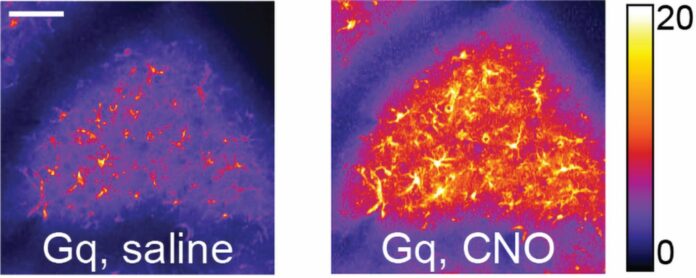Executing all kinds of skilled movements is believed to be implemented by neurons. But a new study by researchers at The Picower Institute for Learning and Memory at MIT shows the essential role of another brain cell type: astrocytes. To learn when and how to move, as well as the ideal timing and direction of a motion, neurons in the motor cortex of the brain rely on surrounding astrocytes.
Scientists found that astrocyte-specific manipulations in the primary motor cortex (M1) during a lever push task alter motor learning and execution, as well as the underlying neuronal population coding. This study emphasizes the intricacy of astrocytes and the significance of interactions between astrocytes and neurons in regulating brain function.
In the study involving mice, scientists identified two specific ways astrocytes directly impact motor learning, maintaining an optimal molecular balance in which the neuronal ensembles can properly refine movement performance.
The group assigned the mice a simple motor task to learn. The mice had five seconds to grab a lever after being tone-cued to do so. The rodents demonstrated that they could pick up the skill over a few days and become experts at it in a few weeks. In addition to doing the task more accurately, they reacted more quickly and pushed and reached with smoother, more consistent motions.
However, the team used precise molecular interventions to disable two distinct astrocyte activities in the motor cortex in a part of the mice. The ability of the astrocytes to absorb glutamate, a neurotransmitter that stimulates brain activity when it is received via connections known as synapses, was altered in specific mice.
The calcium signals of the astrocytes were overactivated in other mice, which impacted their functionality. Both interventions interfered with the natural process by which neurons link to or disconnect from one another, a process known as “plasticity” that facilitates learning.
Each intervention had an impact on the mice’s performance. The mice pushed the lever in the same manner regardless of the first treatment (a knockdown of the glutamate transporter GLT1). Instead, it interfered with the motion’s fluidity. GLT1-disrupted mice remained erratic and unstable, unable to improve their performance. Mice who received the second intervention (activation of Gq signaling) displayed deficiencies in their ability to move smoothly, as well as in their timing and speed when pulling the lever.
To determine how these deficits emerged, scientists used a two-photon microscope to track neural activity in the motor cortex in unaltered mice and mice treated with each intervention. The GLT1-disrupted mice displayed reduced coupled activity among neurons compared to normal mice. Compared to normal mice, mice with Gq activation displayed high correlative activity.
Scientists noted, “The data suggest that an optimal level of neuronal correlation is required for the emergence of functional neuronal ensembles that drive task performance.”
“Meaningful correlations that carry information drive motor learning, rather than the absolute magnitude of potentially nonspecific correlations.”
The group delved even further. They meticulously removed astrocytes from the motor cortex of mice, including some that had not been trained in the motor task and others that had, as well as animals who had undergone each intervention and those that had not. They sequenced the RNA from each sample of pure astrocytes to determine how the gene expression in each sample varied.
They discovered that astrocytes in trained versus untrained mice expressed more GLT1-related genes. They observed reduced expression in mice where they had intervened. This further evidence revealed that training in motor skills requires a fundamental understanding of the glutamate transporter function.
Senior author Mriganka Sur, the Newton Professor of Neuroscience at The Picower Institute and MIT’s Department of Brain and Cognitive Sciences, said, “Here we show that astrocytes have an important role in enabling neurons to encode information properly, both the learning and the execution of a movement, for example.”
Journal Reference:
- Chloe Delepine, Jennifer Shih, et al. Differential effects of astrocyte manipulations on learned motor behavior and neuronal ensembles in the motor cortex. JNeurosci. DOI: 10.1523/JNEUROSCI.1982-22.2023
